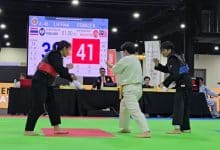Top sports for elders to beat falls & boost bones

Staying active in your golden years isn’t just about adding more candles to your birthday cake; it’s about quality of life. Finding a sport or physical activity that sparks joy can make all the difference. Whether it’s a pastime from your youth or something entirely new, the key is moving your body and having fun while doing it.
With age, the importance of physical activity becomes undeniable. Engaging in sports suitable for your fitness level not only keeps you fit but also offers a fantastic way to socialize and stay connected. From leisurely walks to gentle swims, the options are vast and tailored to ensure you enjoy every moment without the worry of overexertion.
The benefits of taking up a new sport
Physical fitness rockets to new heights when you integrate a sport into your routine. The beauty of sports lies in their versatility, catering to various fitness levels while fostering muscle strength, balance, and coordination. Moreover, indulging in such activities slashes the risk of cardiovascular diseases by a substantial 35%. Not only does your body gain from the rigorous exercise, but your joints revel in the movement, maintaining flexibility and endurance.
Concerning mental agility, immersing yourself in a new sport demands your complete attention and cognitive prowess. Learning the game’s strategies, rules, and techniques sharpens your brain, akin to solving an elaborate puzzle. This mental exercise proves crucial in amplifying focus, memory, and cognitive functions, keeping your mind as agile as your body.
The social aspect of sports cannot be overstated. Starting a new physical activity opens doors to social interaction, a golden opportunity to forge new friendships and connect with individuals sharing a similar zest for sports. Whether it’s team sports or activities like squash, which you can play in pairs or groups, the camaraderie developed on the field often translates to lasting relationships off it.
In the case of sports such as squash, not only does it boost your social circles, but you’ll also torch around 500 calories in just half an hour. It’s a win-win — fostering social connections while keeping diabetes at bay. Similarly, when you consider golf, it’s not merely a leisurely activity; carrying your clubs across nine holes burns over 700 calories. Plus, it envelops you in fresh air, underpinning both your physical and mental health.
As you sift through these options, remember, the end goal is to find a sport that resonates with you, ensuring you reap the rewards of staying active without feeling like it’s a chore.
Different kinds of sports by category
When looking into sports or physical activities that are ideal for elders, it’s essential to consider the level of contact involved. These activities vary widely, fitting into categories such as contact, limited-contact, and non-contact sports, each offering its unique benefits and levels of safety.

Contact sports
For elders keen on staying active, engaging in contact sports might not be the first recommendation. Sports like American football, soccer, and boxing involve players making contact with each other or with objects, posing a higher risk of injury. Although a friendly game of basketball might seem safe enough, it’s prudent for elders to approach these activities with caution.
Limited-contact sports
Limited-contact sports strike a balance. In activities like softball, racquetball, and squash, you might bump into another player, but such incidents are rare if caution is exercised. Playing these sports calls for a blend of vigor and vigilance, as the chances of contact are minimal but present. Whether you’re swinging a racquet or sprinting to bases, remember it’s your preference and comfort that matter most.
Non-contact sports
Non-contact sports present the lowest risk of injury and are highly recommended for elders. Tennis, pickleball, golf, and bowling fall under this category. These activities limit the chances of physical contact with others, focusing instead on skill, precision, and sometimes, team collaboration without the risk. Pickleball, for example, is rapidly gaining popularity among elders for its friendly, low-contact nature and the ease of play.
Sports for over 50’s

When you hit 50, staying active becomes more crucial than ever. Fortunately, there’s a plethora of sports and physical activities perfectly suited for elders. These not only keep you physically fit but also enhance your mental well-being. Let’s dive into some top picks.
Walking
Walking is the ultimate low-impact exercise. It’s something you can do anywhere, requiring no special equipment. Regular walks improve your cardiovascular health, strengthen your muscles and bones, and boost your mood by reducing stress and anxiety. It’s a fantastic way to soak up some vitamin D and enjoy nature’s beauty.
Swimming in later life
Swimming is a blessing for the body, especially in your golden years. It’s gentle on your joints while providing a full-body workout. Swimming laps, joining aqua aerobics classes, or just paddling around can significantly improve your endurance, flexibility, and heart health. Plus, it’s a serene way to unwind and cool down.
Tai Chi for older adults
Tai Chi, a martial art known for its health benefits and low-impact movements, is a godsend for elders. Its gentle, flowing postures improve balance, flexibility, and strength, reducing the risk of falls. Tai Chi also has a meditative aspect, helping to alleviate stress and enhance mental clarity.
Golf for elder
Golf is more than just a leisure activity; it offers substantial health benefits. Walking the course provides a good cardiovascular workout, while swinging the club strengthens your muscles. Golf is also a social sport, offering a great opportunity to meet new people and strengthen friendships.
Walking football
Walking Football retains the joy of the game while eliminating the risk of injury. It’s played at a walking pace, making it accessible regardless of fitness level. This sport not only helps maintain physical fitness but also keeps your reaction times sharp.
Yoga
Yoga is perfect for elders looking to improve their flexibility, balance, and strength. It’s also known for its mental health benefits, aiding in stress reduction and promoting a sense of well-being. From gentle poses to more advanced stretches, yoga adapts to your comfort and ability level.
Cycling
Cycling is another excellent choice for maintaining physical fitness. Whether it’s a leisurely ride through the park or a more vigorous session on the cycling path, this activity strengthens your legs and boosts your heart health, without putting undue stress on your joints.
Bowling / Lawn bowling
Lastly, Bowling and Lawn Bowling offer both physical and social benefits. These low-intensity sports improve hand-eye coordination, balance, and flexibility. They are also fantastic social activities, providing ample opportunities to engage with peers and forge new friendships.
Dancing
Dancing isn’t just a form of entertainment; it’s an excellent physical activity that marries cardio exercise with rhythm and movement. Whether you’re swaying to slow tunes or stepping up the pace with a partner, dancing offers a unique blend of physical and mental benefits. It’s all about the enjoyment of movement, providing a healthy dose of cardiovascular workout that’s as effective as it is enjoyable.
Remember, it’s never too late to start. With the right approach, you can significantly improve your quality of life, keep your bones strong, and stay agile. So, lace up your shoes, and find an activity you love.
Considering all the details shared above there is more to it, Know how to unlock happiness after retirement, It marks a significant milestone in your life, often bringing a mix of emotions and changes. While it’s a time many look forward to, the impact on mental health can’t be ignored. Studies show mixed results, with retirement improving mental well-being for some, while others face challenges.
Parts of this article, including images, may have been generated using AI tools before an editor reviewed it.
Latest Thailand News
Follow The Thaiger on Google News:


























